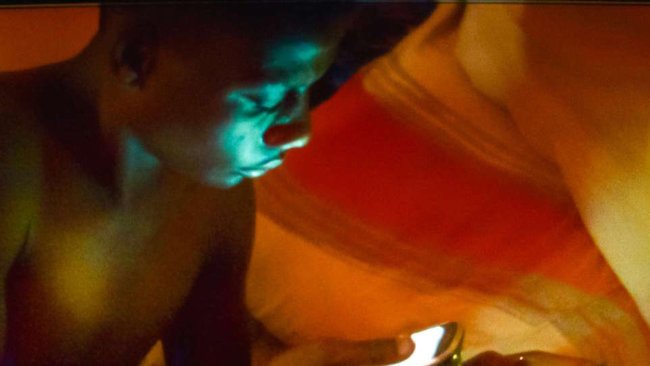Anthropocene and Cinema | Kino Xenix Zürich
I go to the cinema and end up discussing the destiny of the planet… Yes, this can happen, at least during this October when going to the cinema Xenix in Zurich, and discussing with one of the curators of the extraordinary film programme they propose on the Anthropocene. Marius Kuhn is a welcoming person and a passionate discussant. The following text is the result of our conversation.
Text: Giuseppe Di Salvatore

Humans have been everywhere on the planet, and, moreover, their presence and their intervention have changed everything on the planet. Their traces are ubiquitous and are indelible by now. This is the “fact” that makes many people call our (geological) epoch the “Anthropocene”. While certain scientists are occupied with providing some evidence in order to make everyone accept this situation as a “fact”, many other people are already occupied with claiming the negative consequences of this, because the human saturation of the planet seems to be equivalent to the destruction of its life-welcoming ecology.
The Anthropocene as fact and as filmic theme
Now, what about the filmmakers and the cinephiles? Some films reflects on these alarming consequences, they thematise them. Is every film that focuses on the climate crisis or, even better, climate collapse, a film about the Anthropocene? Marius Kuhn and Jennifer Fay, curators of the autumn film programme dedicated to the Anthropocene at the cinema Xenix in Zurich («Wir leben im Anthropozän»), provide us with a more refined perspective on the Anthropocene. For example, they did not focus particularly on catastrophe movies, or documentaries on climate change, but they picked up films that show how the destructive power of the Anthropocene is intimately connected to extractivism and the exploitation proper to capitalism, both necessarily bound to colonialism – until the migration crisis, as Marius stresses. «The debate on Anthropocene allows us to gain a more complex perspective on the urgent question of the climate change», he continues. «If Douglas Sirk’s Written on the Wind [1956] seems to literally point out on the Anthropocene, avant la lettre, it is of extreme interest to see again a film like Roman Polanski’s Chinatown [1974] from the point of view of the Anthropocene, because we’ll discover the connections you mentioned. It’s also this kind of exercise, looking the films from a new perspective, from the point of view of our current concerns, that we would like to propose to our audience.»
 [from Written on the Wind]
[from Written on the Wind]
What is at stake is a predatory and slave mentality, which prevailed on the initial explorative attitude of human beings. It is not a surprise therefore that the Anthropocene implies the paradox of both celebrating anthropocentrism and requiring slavery among human beings.
I find this kind of economic and social criticism to be the best by-product of the debate on the Anthropocene.
The illusion of untouched nature – (also) a filmic question
However, I would like to stress how in this debate such criticism often comes with a nostalgic attitude towards the untouched nature as an ideal world that has been lost, something which is, to my eyes, an incredibly naïve attitude. The idea of “untouched nature” itself, as an alternative to the Anthropocene, is simply contradictory. There probably has been something akin to untouched nature – untouched by human beings – but as such, it is not accessible to us. The fact that we could access untouched nature would presuppose a neutral observer, a neutral observer that science and anthropology have since more than a century sharply deconstructed. Moreover, film and filmmaking are the perfect example of that which we cannot see without touching and deeply intervening in what we see: films show clearly how untouched nature is nothing but an illusion, and eventually a filmic illusion.
 [from Playtime]
[from Playtime]
Plasticity
Likewise, the illusion of nature is exactly at the core of the film that Jennifer Fay has chosen to present at the cinema Xenix – and the one that appears on the cover of her seminal book on the theme, Inhospitable World – Cinema in the Time of the Anthropocene (Oxford University Press, 2018) – Buster Keaton and Charles Reisner’s Steamboat Bill, Jr (1928) – which will be screened with live music (Ensemble Menschenstoff) at the cinema Xenix on the 13th of October. Here, nature is completely created anew in the cinema studios. This can be considered as a way to obliterate nature, just like in the film Marius has chosen to introduce: Jacques Tati’s Playtime (1967). «It’s incredible how with this film we do the experience of a world where nature is completely absent. At the same time, the film is also playful, and in this way Jacques Tati seems to find in it also his own way out of it.» In fact, both Buster Keaton and Jacques Tati are figures of plasticity that, independently of the direct or indirect criticism in the stories that they tell, physically express a tendence towards osmosis, and therefore harmony, with the objects that they playfully handle.
 [from All that Breathes]
[from All that Breathes]
An organic Anthropocene?
The idea of plasticity paves the way for a harmonic ideal of a relationship between humans and their surroundings – living and non-living. In this respect, one should not necessarily dismantle the Anthropocene in order to eschew the bad consequences of the predatory mentality that has still supported its emergence. Humans can learn from other living beings and eco-systems; they can try to live in organic cohabitation with them. This seems to me to be the lesson of films like Shaunak Sen’s All that Breathes or Lemohang Jeremiah Mosese’s This Is not a Burial, It’s a Resurrection – or Tamara Kotevska and Ljubomir Stefanov’s Honeyland, Marius adds. There is – or there could be – a positive side to the Anthropocene. In this regard, I cannot but think of a current flourishing in recent filmmaking – a sort of “organic cinema” – mainly inspired by forms of animism, from Apichatpong Weerasethakul to Luis Patiño.
The series of films in the programme not only thematise the Anthropocene but also question the Anthropocene through the experience that they convey, and through their dispositive as film.
From content to form
Now, cinema seems particularly fit to express these kind of somehow exoteric, organic experiences and probably just because the cinematic dispositive, thanks to its specific feature of being able to represent eccentric experiences, naturally allows us to expand beyond the anthropocentric view. A violent (certainly not organic) example of the eccentric power of cinema is Alfred Hitchcock’s The Birds (1963), also screened in the cinema Xenix. Through this film, and its birds, nature is experienced as threatening, and today as eventually resisting against the totalitarian pretentions of the Anthropocene.
With these last examples, we see that the series of films in the programme not only thematise the Anthropocene but also question the Anthropocene through the experience that they convey, and through their dispositive as film. Let’s say: not only the content but also the form of a film can be relevant for the Anthropocene.
In view of this, I enjoy discovering Jennifer Fay’s final chapter of her aforementioned book and her reference to Siegfried Kracauer’s idea of cinema as anti-humanist technology of defamiliarization. This feature of cinema stresses the unfamiliar aspects of the Anthropocene, that is, its threatening dimension.
Cinema is the revealing figure of the Anthropocene
As dispositive of “world making”, as artificial construction, cinema actually is an exemplary figure of the Anthropocene. Or, even further, cinema «enhances the anthropogenic dimension of the Anthropocene» – as the American scholar writes. On one hand, we could say that with the Anthropocene the world and the nature have become filmic objects, and on the other hand simultaneously, that cinema had its role in the emergence of the Anthropocene, insofar as it has provided its imagination. Cinema as theater mundi or theater naturae anticipated what the Anthropocene later realised. «It is exactly the idea that cinema seems to be predestined to anticipate the idea of Anthropocene that I discovered in Jennifer’s book when I was studying in Nashville», Marius confesses. «It’s there that our collaboration started».

[from Steamboat Bill, Jr]
In her book, Fay underlines the parallelism between the two-sidedness of film production and the Anthropocene: the controlling obsession of the cinema studios (see Buster Keaton recreating the Mississippi weather conditions in the Californian studios of his Steamboat Bill, Jr) opposes the uncontrolled arbitrariness during the shooting; and the complete taming of nature in the Anthropocene conceals its consequent deregulation. From this perspective, a film that reveals its making-of, its artificial construction, would work as a self-critical statement. A self-critical statement that equally concerns the anthropocentric core of the Anthropocene. Cinema thus can also be self-critical in revealing the Anthropocene. «This is why it is so important to open the discussion, through the films that we’re proposing at the cinema Xenix. For example, the booklet that discursively accompanies the films and the discussions with the audience are very important for our programme».
Beyond the Anthropocene – the Otherness of experience
Cinema can also be a true antidote against the Anthropocene I believe and not only its (eventually self-critical) expression. No discovery tool – and cinema is one of them – is a colonial tool. It is enough to imagine a discovery without appropriation, not oriented toward appropriation. Hence, from Auch Zwerge haben klein angefangen (1970) on, Werner Herzog’s films are paradigmatic of the ambivalence of exploration in cinema, between occupation of new territories and glorification of their Otherness. Which is also the ambivalence of experience as such: can we formulate a new experience without making it obsolete?

[from Island of the Hungry Ghosts]
A positive answer to this question will be probably found in the last film that Marius and Jennifer have programmed: Peter Mettler’s While the Green Grass Grows – a work-in-progress episodes-film of which parts II and III will be screened at the cinema Xenix on the 28th of October. After having discovered two other episodes of Mettler’s film at the festival Visions du Réel in Nyon earlier this year I imagine that his filmic journey will continue in the same style, which is a perfect example of film as a decentration tool that allows us to create an experience that does not saturate its object. Marius is particularly happy about having invited Peter Mettler to ideally close the programme: «A criterion of our selection has exactly been not to have a moralising approach to the topic, but to provide a filmic experience that can open the discussion about the Anthropocene. Together with Peter’s films, another beautiful example is Gabrielle Brady’s incredible film Island of the Hungry Ghosts».
Info
Wir leben im Anthropozän | Film programme | Kino Xenix Zürich | 28/9-1/11/2023 | Co-curators: Marius Kuhn, Jennifer Fay
Interview with Marius Kuhn
More Info on the Programme and the meetings
13.10: Exceptional screening with live music (Ensemble Menschenstoff) of Charles Reisner and Buster Keaton’s Steamboat Bill, Jr (1928), with an introduction by the co-curator of the programme Jennifer Fay
28.10: Exceptional screening of parts II and II (work in progress) of Peter Mettler’s While the Green Grass Grows, who will be present
First published: October 07, 2023



